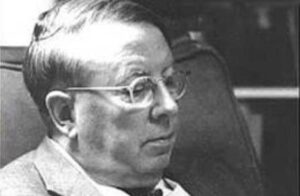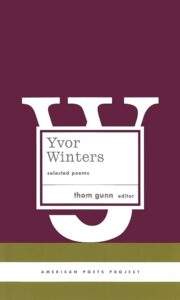Yvor Winters at 20 was an avant garde poet; at 30, he was a formalist
It was the Roaring Twenties, the age of the Lost Generation, T.S. Eliot’s poetry modernism, the Harlem Renaissance, Hemingway and Fitzgerald, speakeasies, Art Deco, keeping cool with Coolidge, and Expressionism. Everything in art and literature was fair game and often was. And young poets like Yvor Winters fit right into the moment.
In Yvor Winters: Selected Poems, poet and critic Thom Gunn tells us that Winters (1900-1968) began his poetry career when he was 20, and was something of a maverick, or avant garde poet. He published his first (and very short) collection, The Immobile Wind, in 1921, and followed it a year later with another short collection, The Magpie’s Shadow. He invented a poetic form, a single six-syllable line. His description of spring rain: “My doorframe smells of leaves.”

Yvor Winters
For his third collection The Bare Wood (1927), Winters tried something more ambitious, numbered and sequenced free verse poems about the seasons in New Mexico. He was living there at the time, as part of his treatment for tuberculosis.
By age 30, Winters changed how he wrote, and the change was permanent. He became a formalist, a poet using traditional (and rhyming) forms like the sonnet. In the context of the time, he was so out there he had come full circle. Formalist poetry was something of a radical statement for a poet in the 1930s; that’s where Winters was, and that’s where he remained.
Winters continued to write poetry for the rest of his life. He was awarded the Bollingen Prize for his Collected Poems in 1961. But it is his literary criticism for which he’s best known today. He was firmly in the camp of what was called the New Criticism, which include Eliot, John Crowe Ransom, Allen Tate, Robert Penn Warren, and others. For poetry, each poem was to be read and understood as its own aesthetic object. And its meaning could be discovered through what we call “close reading.”
This poem was included in Collected Poems, published in 1960:
The Castle of Thorns

From iron to iron pail—old, lined, and pure;
Beneath, the iron is indistinct, secure
In revery that cannot reach to you.
Water it was that always lay between
The mind of man and that harsh wall of thorn,
Of stone impenetrable, where the horn
Hung like the key to what it all might mean.
My goats step guardedly, with delicate
Hard flanks and forest hair, unchanged and firm,
A strong tradition that has not grown old.
Peace to the lips that bend in intricate
Old motions, that flinch not before their term!
Peace to the heart that can accept this cold!
Winters has a reach well beyond formalist poetry. He taught in the English Department at Stanford University; his students included Thom Gunn (noted above), Donald Hall, Philip Levine, N.Scott Momaday, Robert Pinsky, Robert Hass, and many other well-known poets. He helped shape poetry and literary criticism for a considerable part of the 20th century.
And he left us the record of his own poetic journey, finely illustrated in this collection of Selected Poems.
Related:
Discovering a Forgotten Poet: J.V. Cunningham
Poets and Poems: John Finlay Martin and Dense Poems and Socratic Light
Photo by Richard James, Creative Commons, via Flickr. Post by Glynn Young.
How to Read a Poem uses images like the mouse, the hive, the switch (from the Billy Collins poem)—to guide readers into new ways of understanding poems. Anthology included.
“I require all our incoming poetry students—in the MFA I direct—to buy and read this book.”
—Jeanetta Calhoun Mish
- Poets and Poems: Avraham Stern and “A Soldier and a Poet” - July 15, 2025
- Poets and Poems: Beth Copeland and “I Ask the Mountain to Heal My Heart” - July 10, 2025
- A.E. Stallings: the Parthenon Marbles, Poets, and Artists - July 8, 2025


Leave a Reply